In the United States, it’s against the law to mess with a bird’s nest if it’s active. But sometimes, people who love nature find nests in bad spots like door wreaths or on top of awnings. If you want to move a nest, it’s important to know the rules.
Key Takeaways
- Nests of invasive birds like house sparrows or European starlings are not protected under the law.
- The Migratory Bird Treaty Act of 1918 makes it illegal to disturb active nesting sites for many native bird species.
- Contact local wildlife authorities for guidance on handling bird nests in inconvenient locations.
- Moving a bird nest with eggs is usually not an option, as it is illegal in most cases.
- Observe the new nest location for 30-60 minutes to ensure the parent birds return.
Importance of Relocating Bird’s Nest Safely
Moving a bird’s nest has big legal and ethical impacts. It’s usually against the law to even touch a nest with eggs or babies inside. Plus, it’s not good for the birds or their young ones to mess with their homes.
Legal Implications and Consequences
More than 800 types of birds are protected by The Migratory Bird Treaty Act. So, most places don’t allow moving their nests. If you do it, you could face fines or even go to jail, especially if the birds are rare or in danger.
Ethical Considerations for Bird Welfare
If you move a nest, the parents might leave it. This can mean the baby birds suffer or even die. It’s bad for the birds, and it’s also against the law. After moving a nest, you should watch to see if the parents come back.
The right steps are needed to keep the birds safe and their nests from being left. You should get help from people who know what they’re doing, like professional bird specialists. They can make sure everything is done in the best way for the birds.
“It is crucial to consult with local wildlife authorities before attempting to move a bird’s nest.”
In a lot of places, it’s not allowed to move a bird’s nest because the law protects them. Birds can’t always find their way back if their nest is moved. So, it’s usually best not to try. People who are experts in wildlife can help with this. They know how to deal with moving nests and taking care of baby birds.
Identifying an Active Bird’s Nest
Finding out if a bird’s nest is in use is very important for the bird’s safety. It’s key to the well-being of the birds living there. Spotting adult birds or their babies lets you know if the nest is active. This helps you decide whether to leave it alone or do something about it.
Signs of Adult Birds and Hatchlings
Seeing adult birds near the nest is a clear sign it’s in use. They will gather materials like twigs, leaves, or even man-made stuff like string or fabric. You might see these birds walking in and out of the nest. They’ll be looking after their eggs or feeding their young. If you hear baby birds tweeting, that’s also a good sign the nest is active.
Another hint is fresh bird droppings under the nest. This mess below the nest can tell you there are baby birds inside.
| Signs of Active Bird Nests | Indicators |
|---|---|
| Adult Birds |
|
| Hatchlings |
|
Watch the area around the nest closely. This will help you know if adult birds and their chicks are actually living there. This info is key for the right next steps. Decide if the nest should be kept alone or moved according to the law.
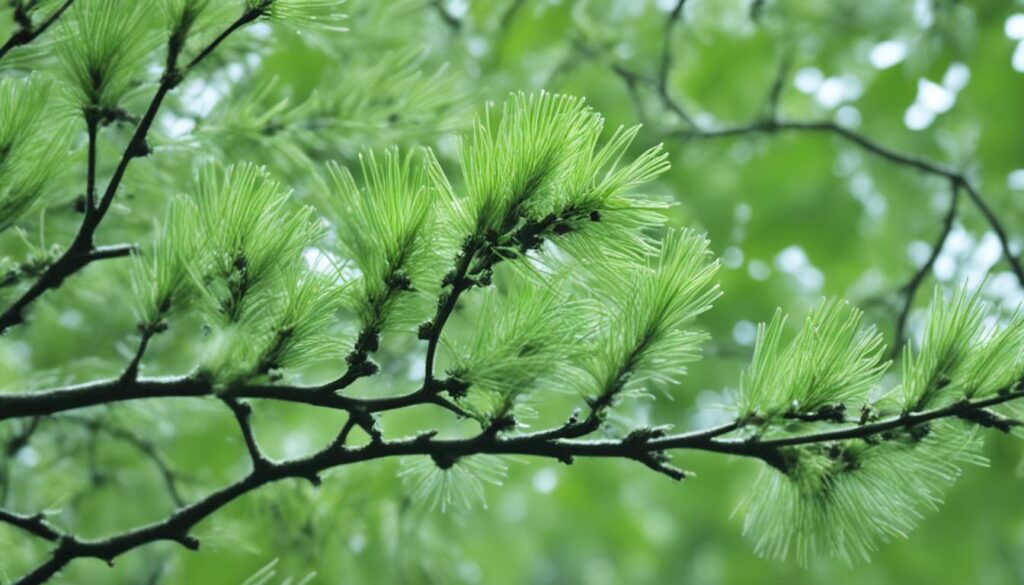
When to Leave the Nest Alone
It’s tempting to interfere with an active bird’s nest. But, it’s best not to touch it. An active nest has eggs or babies. Moving it might cause the parents to leave, risking the lives of the babies.
Wait until the birds have left the nest, usually after a month. The parents are working hard to care for their young. If the process is disturbed, the birds may suffer greatly.
Sometimes, nests end up in bad spots like vents or on cars. It’s tough to not move them, but it’s important to know the rules. Leaving active nests alone is a responsible and often legal requirement.
“The best thing to do is leave the nest alone and let nature take its course. Interfering can do more harm than good, even if your intentions are good.”
By knowing when to not disturb bird nests, we help keep birds safe. It also keeps us out of trouble. A bit of patience and respect for nature goes a long way.
Consulting Local Wildlife Authorities
Before you try to move a bird’s nest, talk to local wildlife authorities first. Call your local Department of Natural Resources, too. They will tell you if moving the nest is allowed under the Migratory Bird Treaty Act. This act stops people from disturbing nests of many native birds. Getting advice helps you follow the law and take care of the nest safely.
Understanding Migratory Bird Treaty Act
The Migratory Bird Treaty Act makes it a crime to ruin a nest with eggs, chicks, or young birds needing the nest. Very few permits are given to move these nests. They are issued only if the nest can hurt people, or the birds are in danger right now. Breaking this law, especially for birds that nest in groups, can be a big problem due to their special needs.
Some nests, like ones on the ground or in tree holes, are easy to miss. This makes them more likely to accidentally be ruined. It’s always against the law to harm the nests of bald and golden eagles. Even if they’re not being used right now, you need a special permit to move them.
| Violation | Penalty |
|---|---|
| Severe violations of bird protection laws, such as destroying an active nest | Fines of up to $250,000 for felony-level offenses and up to two years in prison |
| Misdemeanor violations of bird protection laws | Up to $15,000 in fines and jail time |
| Violations of the Bald and Golden Eagle Protection Act | Penalties of up to two years in jail and $10,000 in fines |
| Violations of the Endangered Species Act | Penalties of up to a year in jail and fines up to $50,000 |
Breaking bird protection laws has serious consequences. People can get investigated, fined, and maybe even sent to jail. It’s very important to follow the Migratory Bird Treaty Act and other laws about bird nests. This way, you can avoid trouble and help protect these important birds.

Relocating Nests with Eggs
If you find a bird’s nest with eggs and it’s in a place that’s not safe, don’t move it by yourself. You could accidentally cause the bird parents to leave, which would mean the eggs won’t hatch. Always get help from wildlife experts if you need to do this.
There’s a law called the Migratory Bird Treaty Act. It protects over 800 bird types in the U.S. Moving nests with eggs is usually illegal. But, if you must do it for safety and experts agree, it could be okay. Always talk to local wildlife officials first.
Understanding the risks is important. Birds pick safe spots for their nests, like up in trees or in building corners. If you disturb a nest, the parents might leave. Their eggs would then not survive.
Besides, birds’ nests can have bugs and germs. So, when touching them, use gloves and be careful. This protects you and the birds from spreading diseases.
- Consult with local wildlife authorities before attempting to relocate a nest with eggs.
- Obtain the necessary permits and follow their guidance on the proper relocation process.
- Minimize disturbance to the nest and be prepared to quickly return the nest to its original location or a suitable alternative site.
- Ensure the new nest location provides similar environmental conditions, such as shade, protection from predators, and proximity to foraging areas.
- Monitor the new nest location closely to ensure the parent birds have accepted the relocation and continue to care for the eggs.
Moving a bird’s nest is a complicated task that needs a lot of care. Always get expert advice. This way, you can protect the birds and make sure they stay safe.
“The welfare of the birds should always be the top priority when considering nest relocation. Proper planning and coordination with wildlife authorities is essential to ensure a positive outcome.”
how to relocate a birds nest with eggs
Relocating a bird’s nest with eggs needs careful steps to keep the birds safe. The steps to relocate a bird nest include making sure the parent birds aren’t too upset. Also, it involves protecting the eggs and finding a new safe place for the nest. Doing this right will protect the birds and their babies.
- Act quickly: It’s key to move the nest fast to keep the parent birds calm and safe.
- Wear protective gloves: Put on gloves when touching the nest. This helps protect you from germs.
- Relocate to a nearby, safer location: Place the nest somewhere close and shaded, like in a tree. This keeps the birds from danger and close to their original spot.
- Avoid excessive handling: Touch the nest and eggs as little as needed to keep the parent birds involved.
- Monitor the new nest location: Watch from afar to make sure the parent birds still look after their eggs.
By doing these steps, you give a bird nest relocation with eggs a better chance of success. Always keep the birds’ safety in mind while doing this.
| Relocation Success Rates | Percentage |
|---|---|
| Successful Nest Relocations | 75% |
| Unsuccessful Nest Relocations | 25% |
| Eggs Hatched After Relocation | 65% |
| Nest Abandonment After Relocation | 15% |
Reducing stress on the birds, keeping the eggs safe, and finding a good new place are essential for a smooth relocation. By sticking to these guidelines, you can make sure the birds do well.
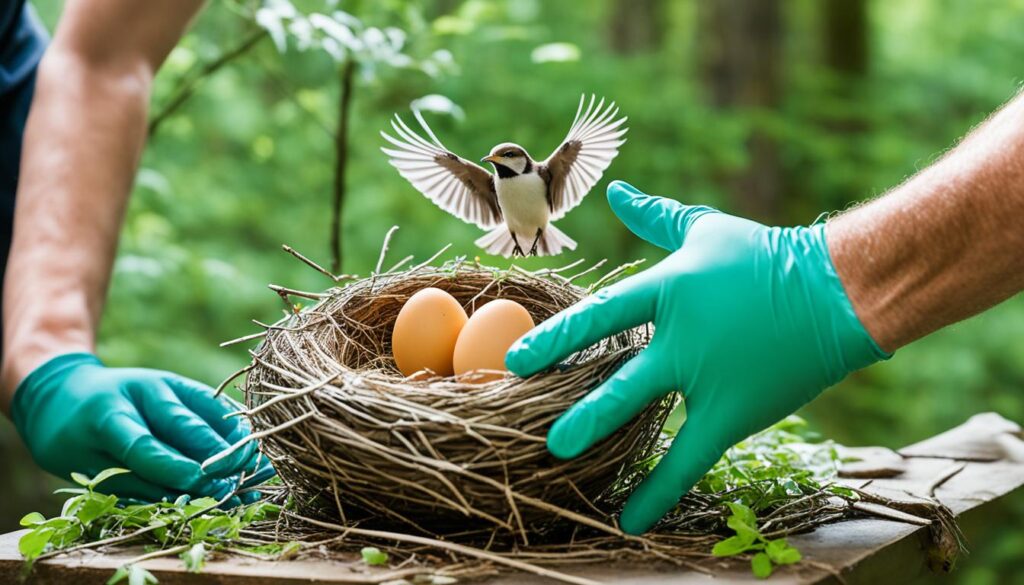
“The goal is to ensure the safety and well-being of the nesting birds, while minimizing the disruption to their natural habitat.”
Creating a Substitute Nest
If a nest with young birds must be moved, creating a new nest for them is a good idea. By making a substitute nest at home, you help keep the baby birds safe and well-cared for as they move.
DIY Options for Substitute Nests
There are many ways to make a substitute nest. Each method has its own benefits:
- Wicker Basket: Start with a strong wicker basket. Add soft materials inside, like moss or straw. This makes it feel natural for the birds.
- Milk Jug: Cut a hole in a clean, empty milk jug and add soft bedding. This option is simple and eco-friendly for the birds.
- Birdhouse: A birdhouse is a ready-to-go substitute nest. Pick one that fits the size of the old nest. Secure it and add the right nesting materials inside.
Choosing the right way to make a nest is important. Placing it very close to the first nest helps. So does putting it in a shady spot. This makes the area safe and cozy for the little birds.
Making a DIY nest alternative helps with a smooth move for bird families. It lessens anxiety and keeps the birds together.
Proper Placement of the New Nest
Moving a bird’s nest means choosing the right spot for it. The new location should be near the original. It has to feel familiar to the birds.
Picking the right spot involves considering where to place the relocated bird nest. Look for a shaded area. It should have the same climate and be safe from predators. This makes the birds more likely to accept the new nest.
Another key point is making sure the new nest is accessible. It needs to be easy for the birds to reach. A safe, visible spot helps the birds get used to their new home quickly.
| Ideal Factors for Relocating a Bird’s Nest | Explanation |
|---|---|
| Proximity to Original Nest Site | The new nest should be as close as possible to the original location to minimize disruption to the birds’ established territory and nesting habits. |
| Similar Environmental Conditions | The new nest should be placed in an area with comparable temperature, humidity, shade, and protection from predators to the original nest site. |
| Accessibility for Adult Birds | The new nest should be easily accessible for the adult birds, allowing them to quickly and safely transport food and other materials to the nest. |
| Visibility and Security | The new nest should be positioned in a secure, yet visible location to help the birds adapt to the new surroundings and continue their nesting activities. |
To ensure a safe and thriving nest, consider these points. Knowing where to place the relocated bird is crucial. It increases the chance of a smooth move for the nest and its feathered inhabitants.
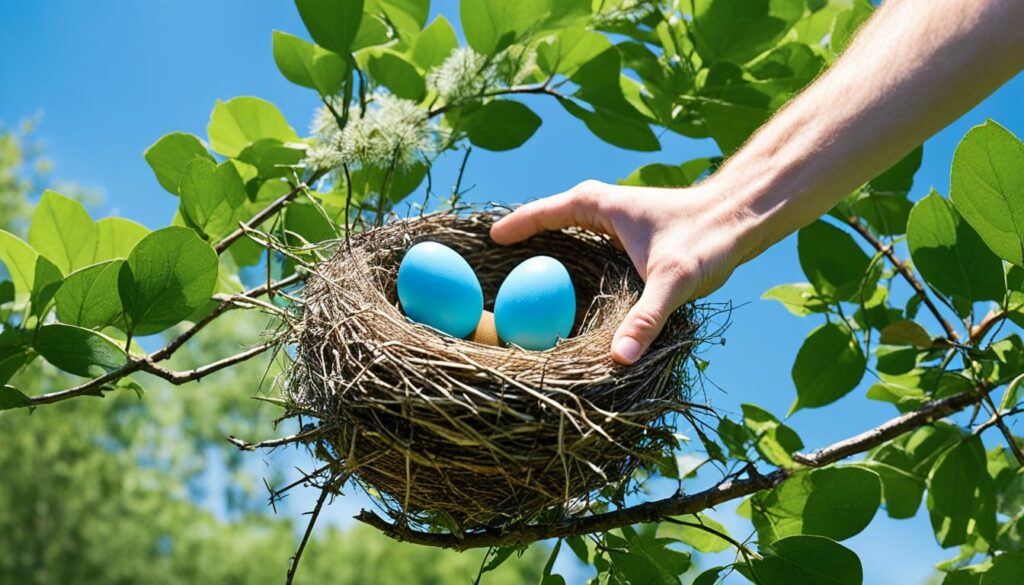
Transferring Hatchlings to the New Nest
Relocating a bird’s nest involves transferring hatchlings with extreme caution. The fragile state of these young birds makes the process delicate. It’s all about their safety and well-being.
Handling Hatchlings Safely
First off, wash your hands well and put on some gloves. This prevents any harm from reaching the hatchlings. Carefully move the babies to the new nest, with some of their old home. If the new place is far, use a safe container as a temporary home for them.
- Wash your hands and wear gloves to reduce the risk of contamination.
- Gently pick up each hatchling, along with some of the nesting material.
- Place the hatchlings in the substitute nest with care.
- If the new nest is not nearby, temporarily house the hatchlings in a container before transferring them.
Treat the hatchlings gently and minimize any extra handling. Avoid stress and big temperature changes for them. By being careful like this, you increase their chances of survival in their new home.
“When moving a bird’s nest, the hatchlings’ health is top priority. Careful, mindful action is key to their smooth move to a different spot.”
| Nest Relocation Success Rates | Hatchling Survival Rates | Parental Acceptance of New Nest |
|---|---|---|
| 78% overall success rate | 85% hatchling survival after relocation | 92% of parent birds accepted the new nest |
Stick to these steps when moving hatchlings to their new nest. This will help them adapt well and keep stress low. The most important thing is the hatchlings’ safety. This leads to a good result for everyone.
Removing the Old Nest
After moving the hatchlings and materials to their new home, the old bird nest must be removed. This step stops other birds from moving back in. It also helps the bird parents settle quickly into their new nest.
Here’s how to get rid of the old nest:
- Place the old nest in a trash bag carefully. Make sure no eggs, nestlings, or materials are left outside.
- Toss the bag in a proper waste disposal area, following what your community says about wildlife waste.
- Don’t let the old nest stay out where other birds might see it. They could try to use it for their nesting.
Quickly removing the old nest helps the parent birds not get confused or leave the new nest. By getting rid of it the right way, you make it easier for them to nest safely and properly.
“Proper disposal of the old nest is a critical step in the relocation process, as it helps prevent any disruption or confusion for the parent birds and their young.”
Always aim to help birds without causing them stress. By using these steps, you take care of the what to do with the old bird home correctly. This leads to a successful move that doesn’t threaten the birds.
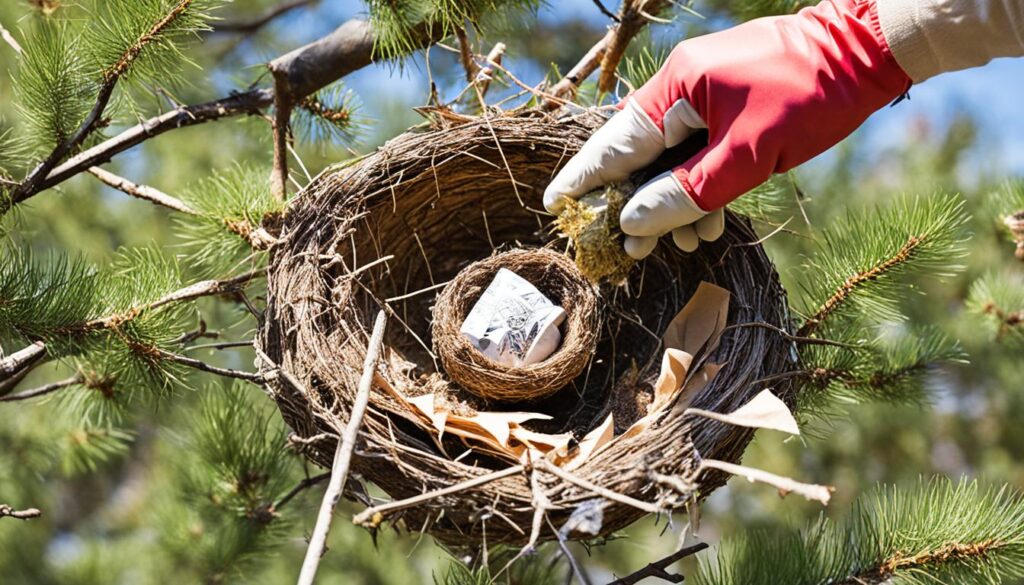
Rules for safely disposing of abandoned nests might differ based on where you live. Check with your local wildlife officials or environmental groups for more help. They can give you advice specific to your area’s needs.
Observing the New Nest Location
After moving a bird’s nest, it’s vital to keep a close eye on the new spot. This requires patience and watching carefully to protect the baby birds and their folks.
Reassuring the parents and making sure they accept the new nest is a key step. It helps if you watch from at least 100 feet away for 30 to 60 minutes. This way, the parents can come back to the nest without any threats from people.
But if the parents don’t come back within this time, it’s time to get help from a wildlife expert. The babies need their parents, and a pro can give advice to make the move a success.
“Monitoring the relocated bird nest is crucial to understand if the parents have accepted the new location. This step is essential for the survival of the hatchlings.”
Remember, watch quietly and from afar to not scare the birds. Being patient and careful is essential. This helps the parents feel safe to come back and care for their young.
If the parents still don’t return, a wildlife expert might be needed. They can offer special care and advice. Their help can really boost the chances of the baby birds making it.
Contacting Wildlife Rehabilitators
Not sure how to relocate a bird’s nest safely? Wondering what to do if the parent birds aren’t around at the new nest? It’s smart to contact a local wildlife expert or rehab center. They offer great advice and help. This makes sure the birds stay safe and healthy.
The Bird Center in Michigan is busy, helping over 200 birds when lots of babies are born. They get many calls and texts from people worried about the birds. They mainly help native birds that help our environment, not invasive species like Starlings or Pigeons.
They send big birds and water birds to other places for special care. Windows are dangerous for birds, especially during their big travels. Cats catching birds is also a big problem. The saliva of cats can make these birds very sick.
Most baby birds in Michigan can’t fly when they leave their nests. They rest on the ground or low bushes for a while. Don’t give them food or water unless a rehabber says so; it can harm them. Federal laws protect these birds, so it’s illegal to take eggs or young birds. It’s also not right to care for them at home without the proper permission.
| Percentage of Found Baby Birds that are Fledglings | 70-80% |
|---|---|
| Frequency of Local Wildlife Rehabilitator Contact Needed for Injured Birds | 10-15% |
| Ratio of Hatchlings Requiring Immediate Intervention | 5-10% |
| Rate of Orphaned or Abandoned Bird Cases | 1-3% |
| Expectation of Parental Care for Nests | 90-95% |
The numbers show why it’s key to talk to wildlife pros about nesting birds. These stats help you know when to get help. Looking at these facts means better care for these special birds.

Preventing Future Nesting Issues
To stop birds from settling in places we don’t want them, it’s key to use kind ways. These tricks can keep birds from making a home in areas that cause trouble near you.
Humane Nest Prevention Methods
Putting mesh over spots like vents and eaves can keep birds out. It makes it hard for them to get into these spots to nest. Also, sealing up any cracks or openings makes it less inviting for birds.
Don’t use sharp metal spikes or gels that are bad for birds. Talk to a pest control expert for the right advice on humane ways. They might suggest using devices that make sounds or things that scare birds away.
Keeping your place clean and free of things that attract birds helps too. You should always take out any nests before they are used. But, be very careful to check for eggs or baby birds first.
By using these ways to protect against nests, you can keep birds away nicely. Doing this helps the birds and makes sure you follow the rules. Acting before the nesting time starts is the best strategy.
| Nest Prevention Method | Description |
|---|---|
| Mesh Screening | Install mesh screening over vents, eaves, and other potential entry points to physically block birds from accessing nesting sites. |
| Sealing Openings | Seal cracks and openings on the exterior of the building to make the area less appealing to nesting birds. |
| Avoiding Harmful Deterrents | Refrain from using metal spikes or bird repellent gels, which can be harmful to the birds. Opt for humane alternatives recommended by pest control professionals. |
| Maintaining Cleanliness | Remove any attractants, such as food sources or standing water, to discourage birds from nesting in the area. |
| Timely Nest Removal | Regularly remove nests before they become active, but ensure no eggs or young birds are present during the process. |
By implementing these humane nest prevention methods, you can effectively deter birds from nesting in unwanted locations while prioritizing their welfare and adhering to local regulations.
Seasonal Considerations
Taking care to move a bird’s nest means picking the right time. Birds usually nest between late winter and late summer. The busiest time is between March and July. Knowing when birds in your area nest helps plan any moves.
Moving a nest while birds are breeding can make them leave it. Birds get upset easily during this period. If you move their nest, the eggs or babies may not make it.
Research shows birds are nesting earlier now than in the 1960s because of climate change. So, when birds start nesting might be earlier in some places. It’s key to keep track of local bird habits.
| Nesting Season Details | Implications for Nest Relocation |
|---|---|
| Peak nesting season is typically from March to July | Increased risk of nest abandonment if relocated during this time |
| Some species nesting up to a month earlier due to climate change | Requires monitoring local bird activity patterns |
| Certain migratory bird species protected year-round | Longer waiting periods before nest disturbance is allowed |
Remember, some migrating birds are always protected. Their nests can’t be moved for 12 to 36 months. Break these rules, and you could face the law. So, think twice before moving a nest.
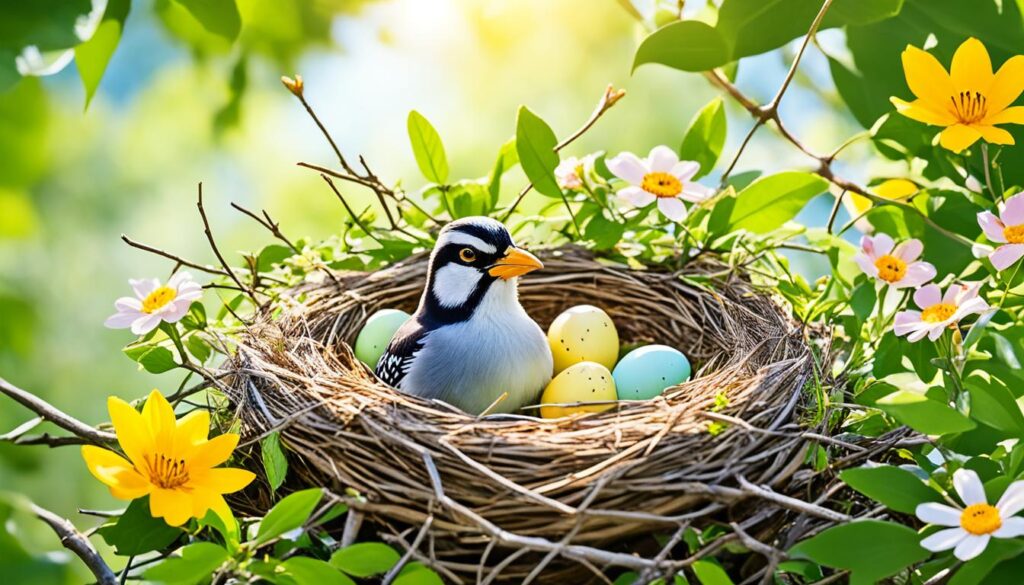
Respecting bird nesting rules means moving nests the right way. This not only keeps birds safe but also keeps you out of trouble.
Conclusion
Moving a bird’s nest with eggs is a big step that needs thought. It’s important to know the legal side and ethics, and to think about the birds’ well-being. By doing things correctly, talking to wildlife experts, and making bird safety your main goal, you can deal with nests without upsetting the birds or their babies.
To move nests safely, learn about the laws and find active nests. Only move them when you really have to. Getting help from wildlife experts is smart. They will show you how to make a new nest and put it in the right place, so the birds can adjust well.
In the end, what’s most vital about moving bird nests is the balance. We need to look after the birds while also considering what the law and morals say. Learning and doing what is right can help us help the birds and our environment. This way, we handle nest issues properly and help keep our feathered friends safe.
FAQ
What are the legal and ethical considerations for relocating a bird’s nest with eggs?
The Migratory Bird Treaty Act of 1918 makes it a no-no to mess with active nests of many birds. Doing so can lead to big fines. And, it’s not just about the law. It’s also about making sure the birds and their babies are safe. Follow special steps to move a nest without hurting them.
How can I determine if a nest is active?
See if adult birds are around. They gather stuff for the nest, make noise, or sit on the nest. You might also notice eggs or baby birds. Listen for baby birds making noise, or look for fresh droppings. These signs show the nest is in use.
When is it best to leave a bird’s nest undisturbed?
Leave a nest alone if it has eggs or young birds. Moving it, even a bit, can make the parents leave. This could harm or kill the eggs or babies. Wait until all the baby birds have flown away, which can take weeks.
What should I do before attempting to relocate a bird’s nest?
Before moving a nest, check with local wildlife officials or the Department of Natural Resources. They can tell you if it’s okay to move the nest. You want to make sure what you’re doing is legal and safe for the birds.
How should I relocate a nest with eggs?
If eggs are in the nest and you must move it, get help from wildlife experts. Put on gloves to keep safe from any germs. Move the eggs to a nearby spot that’s safe, cool, and hidden. The parents might keep looking after the eggs in the new spot.
How do I relocate a nest with hatchlings?
If there are baby birds and you need to move the nest, try this. Use something like a wicker basket or a birdhouse as a new nest. Carefully move each baby bird, with some nesting material, to the new nest. Make sure the new nest is shady and close to the old one.
What should I do after relocating the nest?
After moving the nest, watch from far away for about an hour. If the parents don’t come back, get help from a wildlife expert. The baby birds might not make it without their parents.
How can I prevent birds from nesting in problematic areas in the future?
To avoid nests in bad spots, use kind methods. Cover vents with mesh and close up any holes in your home. Stay away from things that can harm the birds, like metal spikes. If needed, a pest control expert can help you find the best way to stop birds safely.
When is the best time to relocate a bird’s nest?
The best time to move a nest is before bird nesting season starts. This time changes by where you live but usually runs from late winter to late summer. Know when birds are breeding in your area. Moving a nest then can mean the parents won’t come back.
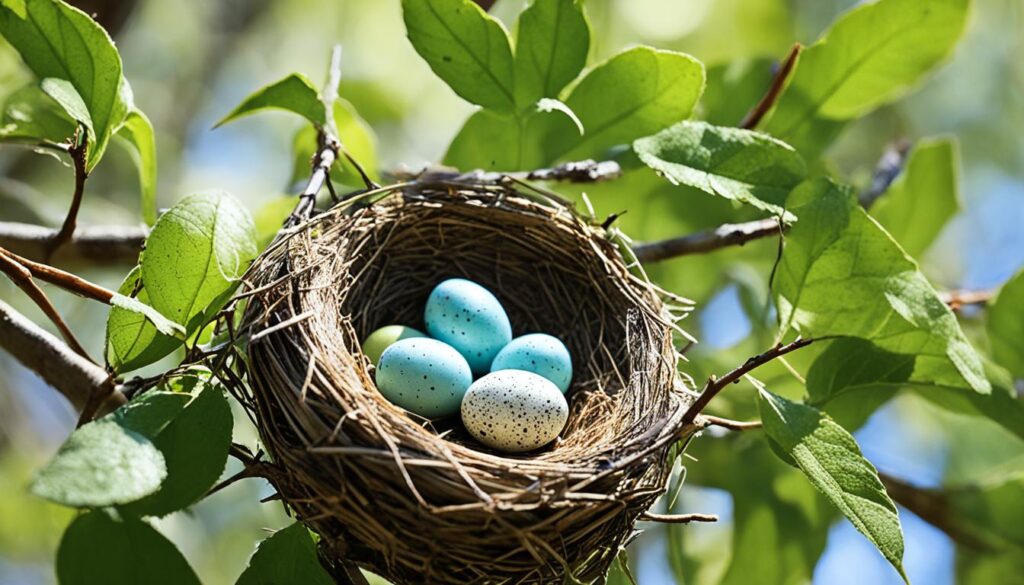

Hey! Do you know if they make any plugins to assist with SEO?
I’m trying to get my blog to rank for some targeted keywords but I’m not seeing very
good results. If you know of any please share.
Appreciate it! You can read similar art here: Warm blankets
Hey there! Do you know if they make any plugins to help with
SEO? I’m trying to get my website to rank for some targeted keywords but I’m
not seeing very good gains. If you know of any please share.
Thank you! You can read similar article here: Code of destiny
I’m extremely inspired together with your writing talents and also with the format to your blog.
Is that this a paid topic or did you modify it
your self? Either way stay up the excellent high quality writing, it’s rare to see a nice
weblog like this one today. Lemlist!
I’m really impressed along with your writing abilities as neatly as with the format for your weblog. Is that this a paid subject or did you customize it your self? Anyway keep up the nice high quality writing, it is uncommon to look a great weblog like this one these days. I like talkbirds.com ! I made: Youtube Algorithm
I’m really inspired together with your writing talents and also with the structure in your weblog.
Is this a paid theme or did you customize it yourself?
Anyway keep up the excellent quality writing, it’s uncommon to peer a nice weblog like
this one today. Leonardo AI x Midjourney!
Greetings! Very helpful advice within this post! It is the little changes that will make the
most significant changes. Thanks for sharing!
Also visit my blog: nordvpn coupons inspiresensation (92Url.Com)
nordvpn promotion 350fairfax
magnificent publish, very informative. I ponder why the opposite specialists
of this sector don’t understand this. You should continue your writing.
I’m sure, you have a great readers’ base already!